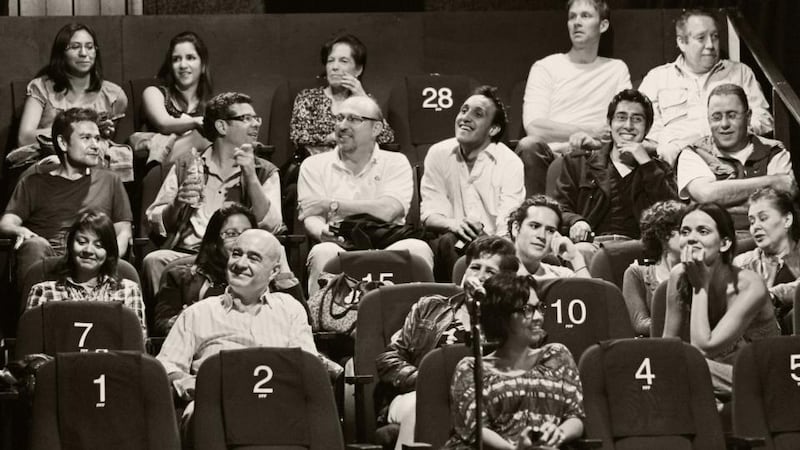On Friday night in Belfast, the performer Rob Drummond took an audience member onstage and asked him, in front of a large crowd, about his religious beliefs and his experience with firearms. In the long history and living memory of this city these questions might have been considered loaded. So, apparently, was the gun that Drummond handed to his volunteer, before calmly asking to be shot in the face.
The performance was Bullet Catch at the Lyric, an artful and moving piece couched in the illusions, delight and heart-stopping tensions of a magic act. Its inclusion in the 51st programme of the Ulster Bank Belfast Festival at Queen's seemed sensitive and considered. Drummond's onstage volunteer was not the only person to be directly involved in the performance, which threaded the story of a magician who died 100 years ago while attempting "the most dangerous stunt in magic", between various breath-taking feats. Several audience members contributed thoughts on the nature of free will and determinism – some solicited, some not, but all entertained – and though the magician did give away some of his tricks, the most stirring of these was magic's reliance on co-operation and collaboration. Such spirit seemed to define this year's festival.
Audience involvement
Indeed, much of new festival director Richard Wakely's first programme depended on direct audience involvement, such as Roger Bernat's political discussion Pending Vote, for which each member could vote on a range of subjects, and the opening festival event, Wish, a contemporary art project realised by the festival's first ever artist-in-residence, Jorge Rodrígues-Gerada, in collaboration with volunteers from communities throughout the city, and the donation of more than 4,000 tons of sand and soil from the city's construction industry.

The project, in Wakely’s words, was “a very deliberate signal of change” towards a festival engaged with “contemporary arts practice, audience participation and global connectivity”.
As Jane Coyle pointed out in these pages last week, the resulting work, spread across an 11-acre site before the Titanic Belfast building, can only be appreciated in its entirety from directly above (restricted viewing, so to speak, was possible from the Titanic building). But the likelihood was that most people would observe it via their televisions, computers and smartphones. The artwork, which received attention from international media, thus took local participation global in ways hitherto unimaginable.
If this remarkable congruence of ideas and display suggested that Richard Wakely’s vision for the programme had a long time to germinate, nothing could be further than the truth.
Wakely, who has had a long international career as a theatre manager and producer of theatre and dance, was appointed to the position in April. Given the vagaries of budgets, company schedules and venue availability, most festival directors will design their programmes over a period of at least a year, and often longer. Wakely had eight weeks.
“I realised I couldn’t have a very high- level curatorial stamp on this,” says the endlessly enthusiastic Wakely. “Instead, I went for favourites and favours. I rang up my favourites and I called in a lot of favours.”
Wakely was born in Nottingham, educated in Belfast and pursued a career as a producer and manager in London and Dublin. He returns to Belfast after a 34-year absence to take a job that many would have regarded as a poisoned chalice. In 2008 the festival clawed its way back from financial straits with title sponsorship from Ulster Bank. In 2011 it resisted political pressure from former Northern Ireland culture minister Nelson McCausland to influence its programme. And last year, its most recent director, Mark Prescott, left the job after less than six months, leaving Shan McAnena to deliver the festival’s 50th anniversary programme. What gave Wakely the confidence to take it on?
“The greatest gift I was given was to be able to look forward,” says Wakely. That is partly to do with the new infrastructural assets of the redesigned and re-energised Lyric Theatre (to which he was a consultant) and the Mac, together with the capacities of this year’s participating Belfast companies such as Prime Cut, Kabosh and Maiden Voyages. But it also has a deeper dimension. “I do believe that all of us on this island have an obligation to put something into the peace process. I felt, personally, I had to do something, and then this came along.”
Breaking even
At the box office, this year's festival has broken even, which is no small feat for a programme that tested the appetite for contemporary practice across all the artforms. Yet there may be further challenges ahead. Ulster Bank's sponsorship is scheduled to end this year (the bank is in talks with the festival about continuing it). Furthermore, Wakely has no fixed-term contract as director and will review his position with staff, colleagues and artists at the festival's concussion, "and just take it one day at a time".
In the hard-earned positivity of Bullet Catch ("There is a point to all this, isn't there?" Drummond concluded. "And it's each other") or the near-liturgical lament of Gébler's Belfast By Moonlight performed in St George's, the city's oldest Church of Ireland church, or the euphoric and eruptive response to Eric Bibb's fine gospel blues, the festival seemed to articulate a profound sense of direct involvement with far-reaching impact.
“Like any wish, it’s ephemeral,” Wakely had said of Rodrígues-Gerada’s project. “Wishes come and go and they change. So will this piece of work, as the grass grows up through it and the place returns to its own natural state.”
That sounded like an equally good metaphor for a festival and its city.











